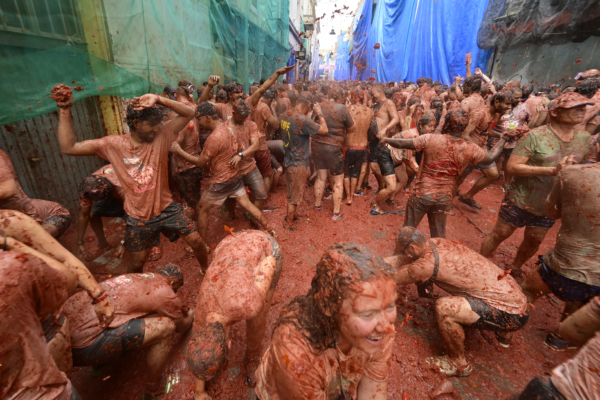On August 27, the small town of Buñol in eastern Spain hosted the annual Tomato Battle, known as La Tomatina. This event has been held since 1945, marking 80 years since the end of World War II, a time when nations around the world are commemorating the milestone.
According to the report by the Associated Press, Buñol, with a population of only 10,000 people, holds the Tomato Battle on the last Wednesday of August each year. This tradition often attracts tourists from all over the world to participate in the fun.
This year, an estimated 20,000 people took part, including visitors who had to pay a ticket fee of 15 euros (17.5 dollars) if they were not locals.
During the one-hour battle, participants used 120 tons of ripe tomatoes brought in by trucks as “ammunition” to throw at each other on a central street. Some buildings were covered with waterproof cloth to prevent them from being stained with the red tomato juice.
The only rule of this war is that the tomatoes must be squashed before throwing to avoid causing harm to others. Despite this, some participants still wore earplugs and goggles for protection.
After the chaotic battle, the street and houses were all covered in a vivid red color. The clothing of participants, as well as almost every inch of exposed skin and hair, were smeared with chunky tomato pulp. White t-shirts were quickly dyed red.
As the Tomato Battle came to an end with a cannon shot, participants washed off the remnants in public showers after the adrenaline-filled event. Workers used hoses to clean the streets of the red stains.
Though the stains on clothing may be tough to remove, the citric acid in tomatoes actually helps clean the roads effectively. Sometimes, the street ended up cleaner after three to four hours than before the event.
Addressing concerns about food wastage, the organizers clarified that the tomatoes used were specifically grown for the Tomato Battle and were not fit for consumption. This year’s tomatoes were provided by a town located five hours away.
Deputy Mayor of Buñol, Sergio Galarza, mentioned, “Without La Tomatina, the tomatoes would not be produced because there would be no demand.”
The tradition of the Tomato Battle dates back to 1945 when local children initiated the playful event, which eventually became a tradition and a highlight of Buñol, also ranking as one of Spain’s most popular festivities.
In 2002, Spain officially recognized the event as an international tourist attraction. Over the past 80 years, the event was only suspended twice in 2020 and 2021 due to the COVID-19 pandemic.
Apart from the tomato hurling, the festival also includes other activities such as concerts and parades.
Similar tomato festival events have been held in places like Florida in the United States, London in the UK, Amsterdam in the Netherlands, Sutamarchán in Colombia, and recently in Hyderabad, India.
However, for the native Galazza, the Tomato Battle is synonymous with Buñol.
Galazza expressed, “In fact, it’s quite exciting because year after year, you can see how La Tomatina evolves and transforms, and you can enjoy a very lively festival.”

